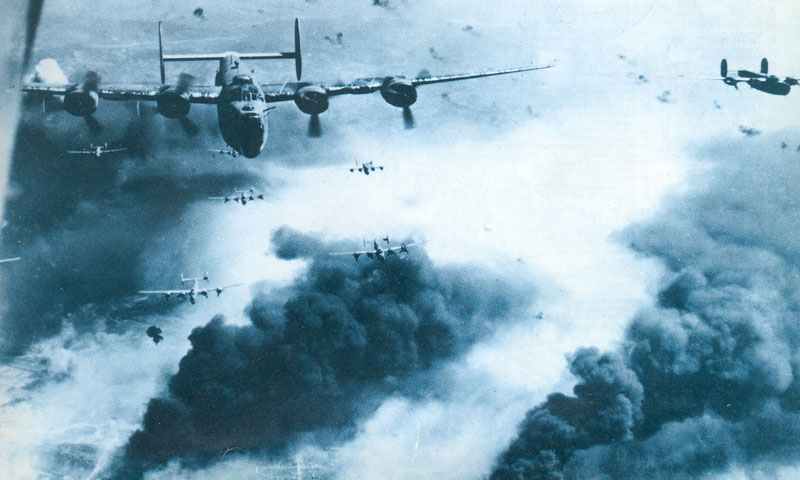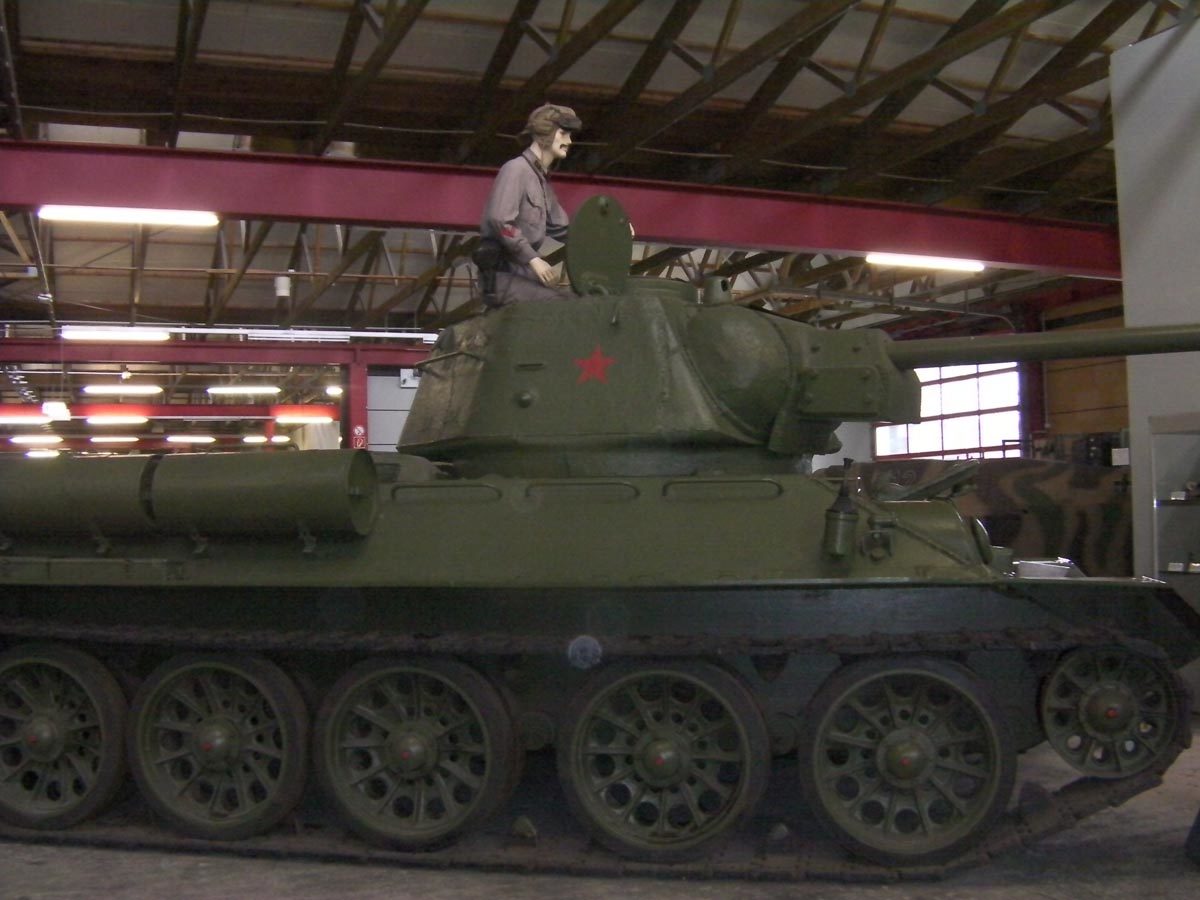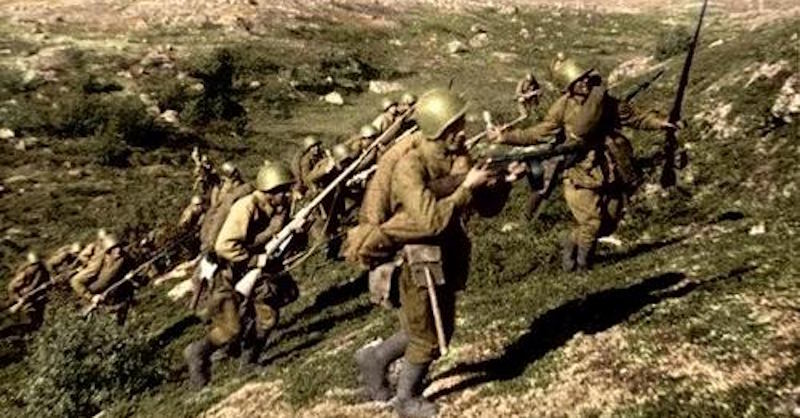Bombing accuracy and targets of USAAF B-17 Flying Fortress and B-24 Liberator bomber groups in Europe during the Second World War.

Bombing accuracy:
With less than 50 per-cent cloud coverage an average B-17 Fortress Group could be expected to place 32.4% of its bombs within 1000 feet (ca. 305 meters) of the aiming point when aiming visually.
The average B-24 Liberator Group under the same conditions could be expected to place 30.4% of its bombs within 1000 feet (ca. 305 meters) of the aiming point.
One box of bombers could contain from 3 to 18 planes. Formations with a three plane frontage could be expected to be 45% more accurate than formations with a nine plane frontage. A six bomber front would be only about 10% more accurate than a 9 bomber front.
The percentage of boxes which could be expected to place at least 10% of their load within 1000 feet (ca. 305 meters) of the aiming point depends upon how many other boxes passed over the target beforehand.
Order of boxes | percentage within 1000ft |
|---|---|
1st Bomber Box | 82% |
2nd Bomber Box | 60% |
3rd Bomber Box | 48% |
4th Bomber Box | 47% |
5th Bomber Box | 30% |
RAF bombers dropped 40% of their bombs within 425 feet (ca. 130 meters) of the aiming point and averaged 38% of their tonnage on target. While it appears that the RAF was vastly more accurate than the AAF, it must be remembered that the ‘AIMING POINT’ for AAF aircraft was usually a single factory building. The ‘AIMING POINT’ for RAF bombers would be the entire city!
Survivability:
B-17 Fortress bomber’s with the 15th Air Force in North Africa and Southern Italy accomplished about 77 missions per plane while those of the 8th AF in Great Britain averaged only 58.9 missions.
B-24’s with the 15th AF typically completed 35.5 missions per plane while those of the 8th AF completed 49.9 missions.
Targets:
The following bomb tonnage taken from the United States Strategic Bombardment Survey show how heavily each of the following industrial complexes were bombed.
Targets in Europe | Bomb tonnage |
|---|---|
Electricity | 251 |
V Weapons | 310 |
Light Metals | 497 |
Machinery | 600 |
Optical and Precision Instruments | 1,003 |
Rubber | 1,687 |
Explosives | 2,154 |
Bearings | 4,407 |
Armaments | 5,344 |
Steel | 5,362 |
Motor Vehicles | 7,380 |
Miscellaneous Factories | 8,809 |
16,990 |
|
Naval and Water Transportation | 19,116 |
Chemical | 31,408 |
Aircraft Factories | 36,832 |
Military bases | 51,332 |
Oil | 163,155 |
Transportation | 351,719 |
Cities (Industrial Areas) | 586,538 |
References and literature
Das Deutsche Reich und der Zweite Weltkrieg (10 Bände, Zentrum für Militärgeschichte)
Luftwaffe – The Game of Aerial Combat over Germany 1943-45, Designers’ Notes & Campain Briefing (Avalon Hill)
Records of the United States Strategic Bombing Survey [USSBS]









The comment about aiming point is misleading. The RAF aiming point was determined by RDF beam, Gee and Oboe and ground radar H2S from 1943 on. The accuracy was more consistent due to using Pathfinders dropping Target Indicators guided by radio aids before and during the raids. Different coloured TIs were obviously more effective during night time. The accuracy of a “Dehousing” bombload (4000lb cookie+ incenduries) could not be assessed due to the munitions not being flight stabilised and fires being spread by wind and target flammability. A better assessment of accuracy would come from looking into individual raids (Operations: Crossbow, Chastise, Gomorrah, and the late war Tallboy dropping Mission against Tirpitz, V sites, submarine pens and the Beilenfeld Viaduct).
USAAF bombing was more accurate than RAF nighttime bombing in good conditions less so in poor. RAF was more consistent but could be jammed or decoyed more easily at night.
What’s missing is the radius of destruction per bomb. Hard to calculate but there ought to be some effort to guestimate. Anyone who’s seen the film of the bombing of Monte Cassino would probably think there was excellent accuracy there – especially given the huge effect of the bombs. The Monastery explodes!
There are some information about this in the articles about Dive bombing tactics and the destruction effect of V-1 impacts.
I think you have your numbers for accuracy mixed up. IIRC the 82% figure for the first box was for putting one (!) bomb within 1000 feet of the target, i.e. dropping several tons of bombs meant that one bomb of around 250 kgs would have a 82% chance of falling within 1000 feet of the intended target.
Everything is as it should. The first box has the highest hitting percentage with 82%, because clearer sight on the target. The second went down to 60% and the fifth just 30%